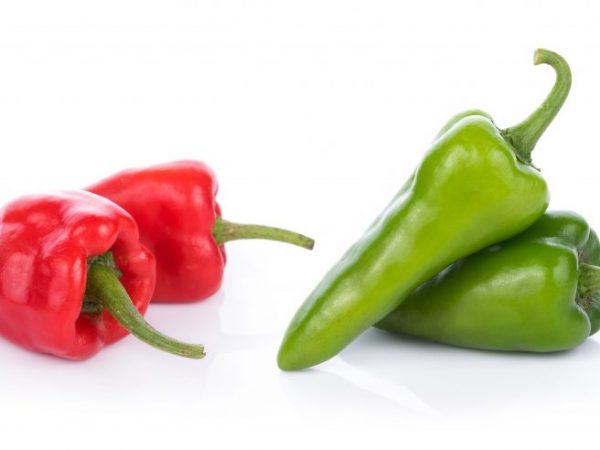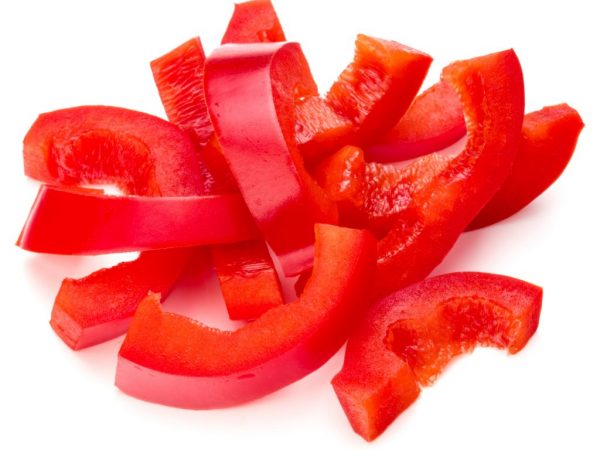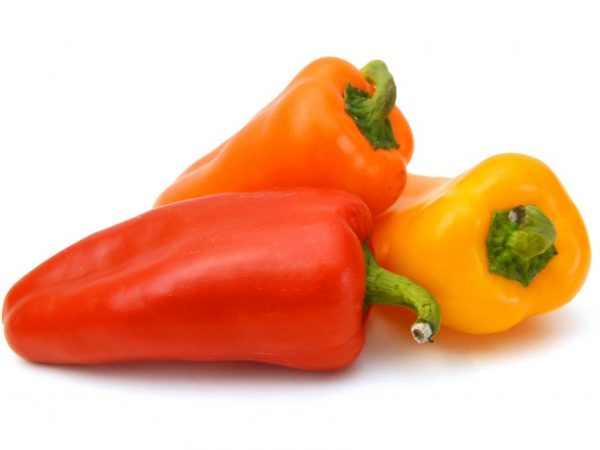Characteristics of the Morozko variety
When choosing a pepper variety, many gardeners prefer the Morozko variety. Pepper Morozko is characterized by cold resistance, early maturity, high yield and ease of care. A detailed description is presented in the article.

Pepper variety Morozko
Variety characteristic
Frost is a sweet pepper grown in open ground and in unheated greenhouses. The first fruits appear in 110-115 days.
The variety has a lot of advantages:
- early maturing;
- resistant to adverse weather conditions;
- disease resistant;
- high-yielding;
- large-fruited.
Suitable for consumption not only fresh and salads, for stuffing, canning and freezing. Transportation and long-term storage is allowed.
Bush
Description of the Morozko bush: a standard plant, closed. The height of the bush reaches an average of 80 cm. The leaves are small, green, slightly wrinkled. When grown outdoors, about 2 kg of crop per 1 m2 can be obtained per season. Indoors - about 3 kg. Up to 30 fruits are tied on the plant at the same time.
Fruit
The fruits of the Morozko pepper have the following characteristics:
- fruits are large and strong, conical shape;
- the mass of one pepper is about 100g;
- the color of the fruit is red;
- wall thickness 5 - 7 mm;
- the pulp is juicy, sweet, with a high content of vitamin C.
The first fruits are plucked already at 110-115 days and put on ripening. If the fruits are brought to maturity on a bush, then the plant will spend energy not on a new crop, but on ripening.
Growing rules
Seed preparation
Seeds should be sown in the second half of February - the first half of March. 65 - 75 days before the expected disembarkation.
For better germination, experienced gardeners recommend soaking them in a growth stimulating preparation. After the seeds have hatched, plant them in peat tablets or soil. The plant does not tolerate any transplants. It is better to plant seeds in large containers with soil. Seedlings will grow in them before planting in a greenhouse or open ground. Don't sow seeds too deep.

Delicious and juicy peppers with proper care
To prevent the topsoil from drying out, create a mini-greenhouse with a film or glass. And when the first shoots appear, remove the film. It is worth considering that the sprouts sprout for about two weeks. All this time, greenhouses must be ventilated and humidified.
Try to keep the temperature at 27 ° C during the day and 17 ° C at night.
Planting seeds
Two weeks before planting, start hardening the seedlings. Expose the sprouts to fresh air. Peppers can be planted in the greenhouse as early as May 15. They are planted without burying the bell pepper. Disembarkation scheme:
- in the greenhouse 40 cm by 60 cm;
- in open beds, less stretched - 45 cm by 45 cm.
Plant peppers on the site in late May and early June. Add humus to each hole.
Landing place
Bell peppers are best planted in the place where legumes, cabbage, carrots, onions or herbs grew before.
The soil must have certain qualities:
- with neutral acidity;
- loose;
- saturated with minerals;
- moisturized.
The site should be sunny, sheltered from the winds. Peppers love soil that contains compost or humus.
Care advice
Caring for Morozko pepper is quite simple.
Peppers love moist soil, so watering is best done two or three times a week in the evening. To enrich the roots with oxygen, fluff the soil regularly.
Feed the peppers with nitrogen fertilizers to improve growth. When the first ovaries appear, start adding potassium and phosphate solutions. During the season, it is necessary to carry out 2-3 feeding.
Remove leaves and shoots that appear on the stem before the first fork. The central flower is also advised to be removed. Compliance with these simple rules helps to increase the yield.
Disease prevention
In order for your favorite pepper not to get sick, follow a few rules:
- take planting material from healthy plants;
- before planting, the seeds should lie down for 3-4 years;
- disinfect the seeds by placing them in a weak solution of potassium permanganate for 20 minutes;
- keep the washed seeds in the "Zircon" preparation, according to the instructions.
Pest control

Pepper is highly susceptible to disease
There are several types of pests that love to feast on our pepper:
- aphid;
- spider mite;
- naked slugs;
- whitefly;
- Colorado beetle;
- bear.
Aphid
Aphids suck the sap from the plant, which causes great harm. Leaves turn yellow, wrinkle and dry. To combat aphids, treat the plant with an aqueous solution of 10 liters of hot water and one glass of wood ash. Leave the mixture for 24 hours. Add 1 tbsp. spoon of laundry soap and stir.
Spider mite
The mite appears on the lower part of the leaf and feeds on the sap of the plant. The leaves of the plant gradually dry out. To remove the tick, prepare a solution of 1 cup of onion or garlic and 1 cup of dandelion leaves. Grind and stir with 1 tbsp. spoon of soap. Dilute this mixture with 10 liters of water. Strain, spray the plant.
Naked slugs
Naked slugs pierce the fruits and leaves of peppers. Gradually, the fruits rot. Weed weeds regularly to prevent slugs. To fight, sprinkle the ground 3 times a day every other day with quicklime. Or place metaldehyde granules in the amount of 5 pieces per 1m2 on the garden bed.
Whitefly
To combat whitefly, rinse each plant with clean water. After that, loosen the soil and add humus or sand with a layer of 2 cm. Such preparations as "Intavir", "Verticillin", "Iskar-M" have shown themselves well in the fight against whitefly. Dilute and apply as directed.
Colorado beetle
The Colorado potato beetle and its larvae are especially gluttonous. They almost completely destroy the leaves of the plant. If there are few insects, it is better to collect them by hand and destroy the eggs. After harvesting, spray the plant with a solution of 1 ml of the Komandor preparation and 10 liters of water.
Medvedki
Bears love dampness. They eat the roots of the plant, causing it to die. To destroy the larvae, loosen the soil between the rows.
Treat the places where the bear congregates with mothballs or kerosene.


